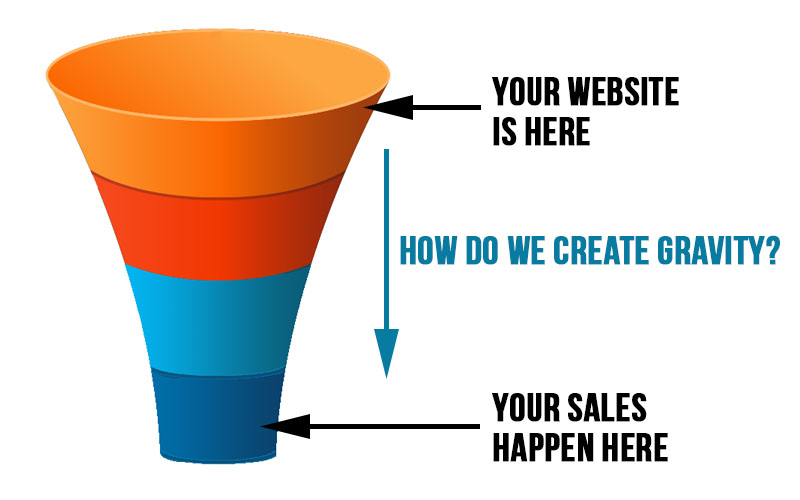Sales funnels are a great visual, but they miss a lot.
The shape of the funnel implies that gravity will pull people down. Just fill the top of that funnel with a huge quantity and it follows that a few people will come out the bottom. You’ll see this thinking all the time on failed shark tank pitches – “the market is enormous, so if I get just 0.1% I’ll be rich!”
The truth is that if you sell a high-ticket product or service, people won’t fall to the bottom of your sales funnel. You’ll have to create the gravity that pulls them to the bottom.
Tip 1: Ask for More Data
Quantity first thinking started with online marketers selling low cost services. An automated sales funnel will sell online courses, low cost software, and other similar services. You may even be able to create a value ladder – building trust and upselling your clients over time. However, that business model isn’t suited towards most professionals.
The conventional script for digital marketers is to maximize the number of emails that they get. They’ll tell you that asking for anything more than a lead’s email address will cause the number of leads to plummet. And they’re right.
Asking for a phone number can reduce the number of people who fill in an online form from 11% to 48%. That would be a disaster for a business with an automated sales funnel.
But if you’re a professional selling a high-ticket service, asking for more information can be a great disqualifier. Would a serious potential client really refuse to be contacted by your office?
In practice, if you sell a high-ticket service you should be asking for a lot more than a phone number. Successful sites should qualify leads – if you can’t help a client, or if there isn’t an intelligent business case for you to work together, then your team shouldn’t be wasting time on a relationship that cannot go anywhere.
There’s a second reason we ask for more – if someone offers you information on their problems, they’ve become invested in finding a solution with you. By asking for more, you’ll get fewer people in the top end of your funnel, but those who do end up in the funnel will be both more qualified and more motivated to get to the bottom of it with you.
Tip 2: Stop Treating Leads like Faceless Avatars
What’s your target market?
Almost every business owner can answer the target market question confidently… problem is, the answer may capture the breadth of their market, but it often misses the nuances that could give you an edge.
Take this sample market: lawyers, between 10-20 people on team, owner of the practice
Add a few more demographic targets, maybe some income requirements, and it’s easy to think that you’ve done a good job targeting people.
Targets that you create on today’s digital marketing platforms don’t really address how diverse the underlying market is. A title attorney likely has most of her business referred by real estate agents, so might be looking to create a wider B2B network of realtors. A criminal attorney needs to reach consumers at a moment of crisis. A civil attorney may be looking for victims to come out of the shadows.
By asking more, you’ll better understand the diverse needs of your clients. However, asking for more information (tip #1) is going to increase your cost per lead, so it would be a tragedy to squander your edge. When you ask for more, you should use it as an opportunity to tailor your products and services to perfectly match the client. If you can’t do that, then they aren’t the right client.
Tip 3: Start Having Conversations
Automation and efficiency – businesses are trying to cut out as much human interaction as possible.
The quantity first approach is constantly minimizing human contact. We go on webinars to avoid one-on-one phone calls, our newsletters are there so that we can stay in touch without getting personal, and our marketing hits broad targets.
There’s certainly a place for broadcast messages and automation, but it isn’t when someone becomes a lead.
Talking to your leads is the ultimate cheat code – but don’t confuse a conversation with a sales pitch. In a conversation, you get the extraordinary opportunity to listen. A sales pitch is one-way, and you should never try to fit your clients to your pre-packaged solution.
Instead, take a step back and listen to the client’s problems. You’ll be able to highlight what products and services fit their problems, rather than trying to come to them with a prepackaged solution. You’ll end up serving your client better, closing more business, and getting more referrals.
Conclusion
Most professionals don’t have a problem with web traffic. You can always buy more clicks to your page. But if you don’t have enough gravity in your sales funnel to pull people from cold leads to great customers, you’ll never be able to buy new customers profitably.
